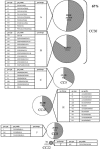Comparison of genetic backgrounds of methicillin-resistant and -susceptible Staphylococcus aureus isolates from Portuguese hospitals and the community
- PMID: 16207977
- PMCID: PMC1248511
- DOI: 10.1128/JCM.43.10.5150-5157.2005
Comparison of genetic backgrounds of methicillin-resistant and -susceptible Staphylococcus aureus isolates from Portuguese hospitals and the community
Abstract
In order to understand the origins of the dominant methicillin-resistant Staphylococcus aureus (MRSA) clones in Portuguese hospitals, we compared the genetic backgrounds of nosocomial MRSA with methicillin-susceptible S. aureus (MSSA) isolates from the same hospitals (n=155) and from the community (n=157) where they were located. Pulsed-field gel electrophoresis, spa typing, multilocus sequence typing, and agr type analysis revealed that the genetic backgrounds correspondent to the dominant MRSA clones in Portuguese hospitals during the last 15 years (Iberian ST 247, Brazilian ST 239, and EMRSA-15 ST 22) were scarcely or not found among the present MSSA collection. The four major MSSA clones encountered (A-ST 30, B-ST 34, C-ST 5, and H-ST 45) correspond, or are very similar, to the background of other international MRSA pandemic clones, i.e., EMRSA-16, New York/Japan, Pediatric, and Berlin clones. However, with the exception of the Pediatric clone, none of these MRSA clones has been detected in Portugal. Our findings suggest the three major MRSA clones identified in Portuguese hospitals have not originated from the introduction of SCCmec into dominant MSSA backgrounds present in the Portuguese nosocomial or community environment but were probably imported from abroad. In contrast, the MRSA Pediatric clone might have originated in our country by the acquisition of SCCmec type IV into MSSA clone C. Furthermore, we provide evidence that the introduction of SCCmec into sensitive clones is most likely a relatively infrequent event that seems to depend not exclusively on the presence of a successful MSSA lineage.
Figures




References
-
- Aires de Sousa, M., and H. de Lencastre. 2004. Bridges from hospitals to the laboratory: genetic portraits of methicillin-resistant Staphylococcus aureus clones. FEMS Immunol. Med. Microbiol. 40:101-111. - PubMed
-
- Branger, C., C. Gardye, J. O. Galdbart, C. Deschamps, and N. Lambert. 2003. Genetic relationship between methicillin-sensitive and methicillin-resistant Staphylococcus aureus strains from France and from international sources: delineation of genomic groups. J. Clin. Microbiol. 41:2946-2951. - PMC - PubMed
-
- Chung, M., H. de Lencastre, P. Matthews, A. Tomasz, I. Adamsson, M. Aires de Sousa, T. Camou, C. Cocuzza, A. Corso, I. Couto, A. Dominguez, M. Gniadkowski, R. Goering, A. Gomes, K. Kikuchi, A. Marchese, R. Mato, O. Melter, D. Oliveira, R. Palacio, R. Sá-Leão, I. Santos Sanches, J. H. Song, P. T. Tassios, and P. Villari. 2000. Molecular typing of methicillin-resistant Staphylococcus aureus by pulsed-field gel electrophoresis: comparison of results obtained in a multilaboratory effort using identical protocols and MRSA strains. Microb. Drug Resist. 6:189-198. - PubMed
-
- Crisóstomo, M. I., H. Westh, A. Tomasz, M. Chung, D. C. Oliveira, and H. de Lencastre. 2001. The evolution of methicillin resistance in Staphylococcus aureus: similarity of genetic backgrounds in historically early methicillin-susceptible and -resistant isolates and contemporary epidemic clones. Proc. Natl. Acad. Sci. USA 98:9865-9870. - PMC - PubMed
-
- Enright, M. C. 2003. The evolution of a resistant pathogen—the case of MRSA. Curr. Opin. Pharmacol. 3:474-479. - PubMed
Publication types
MeSH terms
Substances
LinkOut - more resources
Full Text Sources

